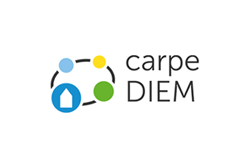Local optimized energy management
Simulations
The role of a locally optimized power system (e.g. a village grid) within the national and international power system was analyzed. We addressed the questions what effect a local optimization has on the CO2 balance of the bigger system consisting of the German power system and the connected power systems of the neighboring countries. Further simulations revealed the best economic solution.
Different scenarios were simulated of which four are introduced in this report.
Seen from the greater perspective, does it make sense to locally optimize energy management?
Further questions are discussed:
When does the local residual load curve acts supportive to the overall system?
Can storage increase supportive times?
In which cases can CO2 emissions of the total system be reduced?
What is economically the best solution?
What is important for the overlaying system?


The overlaying power system was considered to be Germany and the connected power systems of neighboring countries.
The data of our model village as well as German and the surrounding neighboring countries was collected and inserted into the model. Loadcurves for every hour of the year were stored.
The subsystem can act supportive to the overlaying system or not, depending on the very scenario conditions. The subsystem is supportive to the overlaying system in case it can provide excess power in times when the overlaying system lacks energy, or vice versa.
Here four different scenarios are depicted A,B,D and F comp. figures above.
More settings were simulated (hence the numbering).They can be found in a detailed report ('EUF report: Sub-autonomous micro-grids in the national power system')as well as the possibility to access all simulations under github.com/znes/carpeDIEM.
Induced and avoided CO2 emissions
The simulations allow to determine the CO2 emissions for the described scenarios. We destinguish between an isolated village with storage that is only locally availble and an integrated case where the storages are allowed to be integrated in the overlaying power system.
| Scenario | CO2 (t/a) |
|---|---|
| A Base case | 0 |
| B Prosumer batteries | 9 |
| D PV and centralized battery | 45 |
| F Wind and centralized battery | 7 |
The table lists the results for an isolated case. The positive values show that for all scenarios we have additional CO2 emissions, the reference case is set to zero.
The results for the integrated approach, as in the next table, show, that in this case for all scenarios CO2 emissions can be avoided, hence negative values appear for CO2 emissions.
| Scenario | CO2 (t/a) |
|---|---|
| A Base case | 0 |
| B Prosumer batteries | -7 |
| D PV and centralized battery | -48 |
| F Wind and centralized battery | -5 |
Costs
The economic data can be categorized into central and decentral batteries. For decentral batteries it was assumed that the technology of Vanadium Redox Flow (VRF) batteries is utilized whereas for the centralized approach Li-ion batteries were assumed.
This takes into account that a VRF battery would be the most cost effective village solution according to the evaluation of our partners from THL. In the calculations, a mean value of the technology-specific cost range was applied, i.e. 985 and 855 Euros per kWh, respectively. Moreover, financial parameters such as an interest rate and a depreciation duration were inputs to the calculations.
| Scenario | Costs | Costs |
|---|---|---|
| €/a | €/a | |
| Period | 20a | 30a |
| B Prosumer batteries | 2729,73 | 1819,82 |
| D PV and centralized battery | 2370,18 | 1580,12 |
| F Wind and centralized battery | 5416,66 | 3611,10 |
The scenario setting D appears to be the one in which an integrated approach reduces CO2 emissions most compared to the isolated approach. A centralized battery storage seems therefore more beneficial than multiple distributed battery storages.
Economy of local battery systems
The residual load curves of the sub-system were further analyzed with reference to potential financial yields from sales and purchases of electricity to the overlaying power system.
The theoretical cost and benefit of a reference case was calculated and so was the theoretical cost and benefit of the cases with battery storages. It was found that the battery storage indeed would reduce the amount of money to be spent for electricity purchases in times of low production. On the other hand it was detected that in most cases the return of sold electricity would also be reduced, even further than the increase of cost savings. As shown in table 5, the balance of both cost and benefit resulted in negative values in scenarios B and D whereas in scenario F a positive value was found. However the cost for the battery needs to be set against any savings.
Income from power sales and expenses for power purchases (all figures in Euro).
| Scenario | Income | Expenses | Balance | Relation to reference case |
|---|---|---|---|---|
| A | 75500 | 18183 | 57317 | |
| B | 73552 | 16821 | 56731 | -586 |
| D | 60475 | 5079 | 55396 | -1921 |
| F | 123639 | 4812 | 118829 | 643 |
Key findings
- In the cases of an isolated approach, additional CO2 emissions would be induced in the overlaying power system. It can be concluded that the integrated approach reaches the lowest CO2 emissions in the simulated scenarios and any isolated approach leads to a sub-optimal solution.
This indicates that battery storages should be made centrally dispatchable, if possible, in order to minimize CO2 emissions. In comparison with other storage options, however, battery storage constitutes an expensive way to store energy.
To sum up, batteries might make sense from a system perspective if other flexibility options are not available or not reasonable – but the batteries’ ability to charge and discharge should be made available to the entire power system. - Does it make sense to attach a local battery storage to a micro-grid?
From a user’s point of view, it might make sense to buy a battery and include it in a micro-system. This could save money if it allows to avoid cost-intense peak power purchases or if the link with the overlaying power system – e.g. an inverter or a power line – is too weak to transport all the power that is either surpluses in the sub-system or that needs to be obtained from the overlaying power system. A fair comparison of options, however, should include grid reinforcement then, too.
From a macro-perspective, local batteries can help reduce CO2emissions if the batteries are made available to the entire power system, i.e. if their charging and discharging is conducted along the system’s needs. If they are not, their behavior in the entire power system will always be suboptimal.
Conclusions
•An “optimization“ of a local sub-system can induce additional CO2 emissions in the overlaying power system.
•The integration of storages in the overlaying system will reduce CO2 emissions.
•In any case battery storage is an expensive option to reduce CO2 emissions.
•Recommendation: if battery storage is desired, it should be made centrally dispatched.
The simulations are based on the current net infrastructure. Including storage in a local environment might make sense:
•if the local infrastructure is limited to an extent that further use of renewables could not be integrated.
•for remote systems, basically also because for them the net infrastructure is limited.
•if the net stability could profit from storage solutions, especially when renewable sources increase their share on the electric market.



